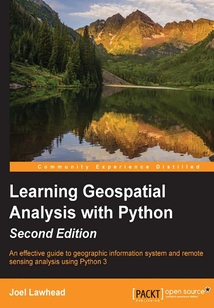舉報 

會員
Learning Geospatial Analysis with Python(Second Edition)
最新章節:
Index
IfyouareaPythondeveloper,researcher,oranalystwhowantstoperformGeospatial,modeling,andGISanalysiswithPython,thenthisbookisforyou.FamilaritywithdigitalmappingandanalysisusingPythonoranotherscriptinglanguageforautomationorcrunchingdatamanuallyisappreciated.
目錄(126章)
倒序
- 封面
- 版權頁
- Credits
- About the Author
- About the Reviewers
- www.PacktPub.com
- Support files eBooks discount offers and more
- Preface
- What this book covers
- What you need for this book
- Who this book is for
- Conventions
- Reader feedback
- Customer support
- Chapter 1. Learning Geospatial Analysis with Python
- Geospatial analysis and our world
- History of geospatial analysis
- Geographic information systems
- Remote sensing
- Elevation data
- Computer-aided drafting
- Geospatial analysis and computer programming
- Importance of geospatial analysis
- Geographic information system concepts
- Common vector GIS concepts
- Common raster data concepts
- Creating the simplest possible Python GIS
- Summary
- Chapter 2. Geospatial Data
- An overview of common data formats
- Data structures
- Spatial indexing
- Overviews
- Metadata
- File structure
- Vector data
- Raster data
- Point cloud data
- Web services
- Summary
- Chapter 3. The Geospatial Technology Landscape
- Data access
- Computational geometry
- Desktop tools (including visualization)
- Metadata management
- Summary
- Chapter 4. Geospatial Python Toolbox
- Installing third-party Python modules
- Python networking libraries for acquiring data
- Python markup and tag-based parsers
- Python JSON libraries
- OGR
- PyShp
- dbfpy
- Shapely
- Fiona
- GDAL
- NumPy
- PIL
- PNGCanvas
- GeoPandas
- PyMySQL
- PyFPDF
- Spectral Python
- Summary
- Chapter 5. Python and Geographic Information Systems
- Measuring distance
- Calculating line direction
- Coordinate conversion
- Reprojection
- Editing shapefiles
- Performing selections
- Creating images for visualization
- Dot density calculations
- Choropleth maps
- Using spreadsheets
- Using GPS data
- Geocoding
- Summary
- Chapter 6. Python and Remote Sensing
- Swapping image bands
- Creating histograms
- Clipping images
- Classifying images
- Extracting features from images
- Change detection
- Summary
- Chapter 7. Python and Elevation Data
- ASCII Grid files
- Creating a shaded relief
- Creating elevation contours
- Working with LIDAR
- Summary
- Chapter 8. Advanced Geospatial Python Modeling
- Creating a Normalized Difference Vegetative Index
- Creating a flood inundation model
- Creating a color hillshade
- Least cost path analysis
- Routing along streets
- Geolocating photos
- Summary
- Chapter 9. Real-Time Data
- Tracking vehicles
- The NextBus agency list
- The NextBus route list
- NextBus vehicle locations
- Mapping NextBus locations
- Storm chasing
- Reports from the field
- Summary
- Chapter 10. Putting It All Together
- A typical GPS report
- Working with GPX-Reporter.py
- Stepping through the program
- The initial setup
- Working with utility functions
- Parsing the GPX
- Getting the bounding box
- Downloading map and elevation images
- Creating the hillshade
- Creating maps
- Measuring the elevation
- Measuring the distance
- Retrieving weather data
- Summary
- Index 更新時間:2021-07-23 14:46:19
推薦閱讀
- DevOps:軟件架構師行動指南
- C# Programming Cookbook
- INSTANT Weka How-to
- 區塊鏈:以太坊DApp開發實戰
- 深入淺出Android Jetpack
- Java Web程序設計
- Web全棧工程師的自我修養
- 云計算通俗講義(第3版)
- Python 3破冰人工智能:從入門到實戰
- Rust Essentials(Second Edition)
- Yocto for Raspberry Pi
- 零基礎輕松學SQL Server 2016
- Instant PHP Web Scraping
- Java Fundamentals
- CRYENGINE Game Development Blueprints
- 深度學習原理與PyTorch實戰(第2版)
- 算法超簡單:趣味游戲帶你輕松入門與實踐
- React and React Native
- 陪孩子像搭積木一樣學編程:Python真好玩+Scratch趣味編程(全2冊)
- HTML 5與CSS 3權威指南(第3版·下冊)
- Instant Windows 8 C++ Application Development How-to
- Hadoop技術內幕:深入解析HadoopCommon和HDFS架構設計與實現原理
- Odoo Development Cookbook
- Statistics for Machine Learning
- VMware NSX Network Essentials
- Android App開發入門與實戰
- SAP Lumira Essentials
- Java Web程序設計教程
- 代碼質量
- 超級軟件:下一代互聯網云平臺

